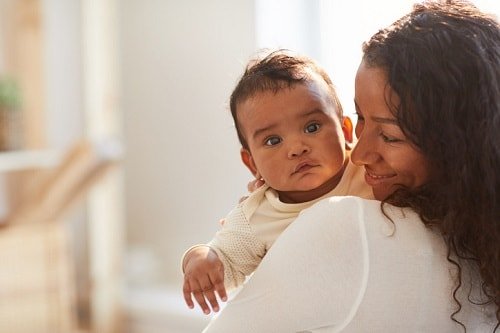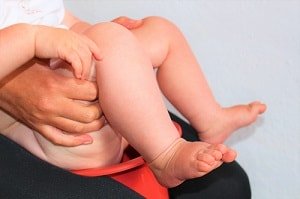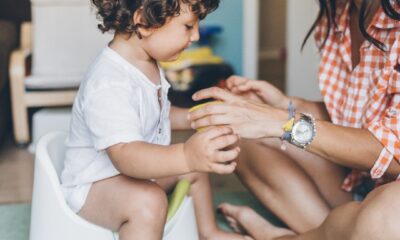Advice
Infant toilet training: The scientific evidence

Widely practiced in traditional cultures, infant toilet training is becoming more popular in Western countries. But what are the pros and cons of early training? How do you actually do it? And what does science tell us about the development of bladder control?


If you grew up in a culture that uses diapers, infant toilet training might seem unconventional and exotic. But in traditional societies throughout the world — in Asia, Africa, Eastern Europe, Latin America, and the Arctic — infant training is the norm.
When babies need to urinate or defecate, their parents hold them, bare-bottomed, over a preferred target (like a waste receptacle, or an outdoor latrine). The parents signal the babies to proceed, and the babies respond (Boucke 2003; Duong et al 2013a; Sonna 2006; deVries and deVries 1977).
How do parents know when their babies need to eliminate?
There isn’t any magic here. The parents pay close attention. They learn to read their babies’ cues. And eventually, after multiple trials, babies learn to hold back until their parents give them the signal — usually a special vocalization, like “sheee-sheee,” or “shuuuus” (Bouke 2003; deVries and deVries 1977).
In other words, it’s all about communication — what some folks call “elimination communication.” And it’s becoming more popular in Western countries, like the United States (Bender and She 2017).
But are these babies truly “toilet trained”?
That depends on what you mean. Young babies can’t walk, wipe, or dress themselves. So they aren’t “trained” in the sense of being capable of taking independent trips to the toilet. But toilet sessions become more coordinated, organized, predictable. And families can go “diaper free.”
Is this a goal worth pursuing? When should parents begin infant toilet training? What procedure(s) should they follow? And what does research tell us about the development of bladder and bowel control? Is early training a good choice for your baby?
Here are the details to help you decide. I cover the potential benefits of infant toilet training, and outline the general procedure associated with elimination communication. In addition, I provide a link to an alternative method of infant potty training, and review some of the developmental (and cultural) factors that can make infant training difficult.
What are the benefits of infant toilet training?
Infant toilet training depends on establishing close communication about the baby’s frequent needs to eliminate. It’s time-consuming, but potentially rewarding in the same way that communication about feedings can be rewarding.
In addition, infant toilet training makes it possible for families to reduce — or eliminate — their usage of diapers. This means
- saving money on diapers and diaper paraphernalia;
- generating fewer non-biodegradable, disposable diapers; and
- using less energy to wash and dry cloth diapers.
It also means avoiding diaper rash and diaper-related infections, and might help babies develop regular defecation habits.
In a recent study conducted on folks practicing elimination communication in a Western country (Austria), researchers found that the more time infants spent diaper-free, the less frequently they experienced rash. In addition, going diaper-free has linked with a more “regular defecation frequency” (Geist et al 2023).
Any long-term benefits?
Parents may avoid difficulties associated with toilet training older kids
Parents who train early may avoid certain pitfalls, at least when compared with parents who delay training until children are over the age of two or three. When kids have spent years wearing diapers, parents often face these difficulties:
- Older children have learned to ignore their own body signals and must re-learn them.
- Older children are used to wearing soiled diapers and may resist change.
- Older children are more likely to test your authority when you ask them to comply with potty training.
Children who begin training in infancy may avoid certain health problems
There’s some evidence that infant toilet training helps babies learn how to completely empty their bladders when they urinate (Duong et al 2013b). This is potentially important, because residual urine in the bladder can lead to urinary tract infections.
And there’s reason to think that early elimination communication could lower a child’s risk of developing bladder and bowel dysfunction (or BBD). In a survey-based study of the outcomes more than 10,000 of kids in China, researchers compared two groups of youngsters:
- Children who began elimination communication before the age of 12 months
- Kids who never practiced elimination communication
Among children who had practiced early elimination communication, only 1.36% had trouble with bladder and bowel dysfunction. Among kids who had never practiced elimination communication, 15.71% experienced bladder and bowel dysfunction (Xu et al 2021).
What is the downside?
There is more work involved — the kind that involves regular monitoring and check-ins. Accidents happen, too (see below). And in that study of parents practicing elimination communication in Austria, researchers found that time spent diaper-free impacted parental sleep — reducing the amount of continuous (uninterrupted) sleep (Geist et al 2023).
So when should a baby start toilet training?
It isn’t really a matter of “should.” Some parents start right after birth (Duong et al 2013a; Boucke 2003). Others wait until 3-6 months (Schaefer and DiGeronimo 1997; Smeets et al 1985).
What’s the procedure? How does infant toilet training work?
Typically , parents follow these steps:
1. Become familiar your baby’s elimination patterns.


How does your baby behave just before he or she eliminates? Some babies may squirm or shudder just before they have to go. Others might change their breathing patterns, or begin crying, or adopt a particular facial expression.
In addition, pay attention to timing. Babies may tend to urinate shortly after a feeding. They may void just before — or immediately after — sleeping. Some babies may urinate pretty regularly, once an hour or so.
Watch for these patterns, and learn to anticipate when your baby is about to go.
2. When your baby shows signs of needing to eliminate, provide the opportunity: Hold your baby’s bare bottom over an appropriate receptacle.


This doesn’t have to be a toilet. For young babies, some parents use plastic tubs or bowls (Boucke 2003; Sonna 2006). In traditional cultures, babies often urinate outdoors, on the ground.
3. Teach your baby to associate the act of eliminating with a signal of your choosing.
In many parts of the world, parents make a characteristic sound or gesture while the baby voids. Babies learn to associate the sound with the action.
4. Once your baby has learned the signal, use it to encourage your baby to eliminate on cue.
Now you have some influence over the timing of toileting. For example, before you take your baby on an outing, you can ask your baby to void. Provide the opportunity, and give your baby the signal. Similarly, you can invite your baby to eliminate after meals, or just before bedtime.
Are there any alternatives to this method?
Yes. If your baby has reached the milestone of being able to sit up independently — without being held in place, or propped up by objects — you can try a different technique that makes us of an infant potty chair.
This approach has been investigated by Western researchers (Smeets et al 1985), and tested on a small number of babies — with success. If you’re interested, be sure to check out my Parenting Science guide to this alternative infant toilet training method,
How long does it take before a baby is “trained”?
In cultures that practice traditional infant training, infants complete training between 6-12 months (Duong et al 2013a; Boucke 2003; deVries and deVries 1977).
And in a study testing the alternative (potty chair) method, the participating infants completed training before they were 12 months old (Smeets et al 1985).
But hang on…how is any of this possible?
Aren’t babies supposed to be incapable of bladder and bowel control?
Granted, babies aren’t miniature adults. They can’t control elimination to the extent that we can. For example, in one study, researchers found that only 20% of children attained “complete” bladder and bowel control by the age of 2 years (Largo et al 1978).
But infant potty training does not require “complete” control. For training to be successful, babies need only follow some predictable patterns, and be capable of partial control.
These requirements are met rather easily for bowel movements. After the newborn period, bowel movements are relatively infrequent, and the warning signs of an impending bowel movement are pretty easy to read. Parents and babies have time to react.
And for urination?
Granted, bladder training is more difficult. Infants have small bladder capacities and process large volumes of liquid. They urinate frequently, and it can be hard to tell when they are about to pee.
In addition, some young infants may have trouble coordinating their muscles.
They can contract the bladder wall (which increases pressure inside the bladder) and they can relax the urinary sphincter (which opens the urethra and permits urine to flow outside the body). But they may have trouble doing both at the same time. As a result, they may not completely empty their bladders with every voiding (Yeung et al 1995; Sillén et al 1996; Bachelard 1998).
But this doesn’t mean that babies urinate in a random, haphazard way. On the contrary.
As noted above, babies are more likely to urinate at certain times during the day.
They are more likely to urinate after feedings. They are also more likely to pee when they are fully awake, or transitioning to waking. Babies tend not to urinate when they are in “quiet sleep” — an infant sleep stage analogous to our adult stage of “deep” sleep (Yeung et al 1995; Wen and Tong 1998).
And just as importantly, baby bladders aren’t hopelessly weak or erratic.
The muscles of the bladder wall are usually stable, contracting only around the time of urination (Yeung et al 1995; Wen and Tong 1998). And when researchers have tried to provoke healthy newborns to urinate by manually pressing their bladders, it didn’t work. The bladders didn’t leak (Gladh et al 2000).
So research refutes the notion that baby bladders are totally uninhibited (Sillén 2001; Yeung et al 1995).
Infant urination is not merely an automatic reflex (Sillén 2001; Yeung et al 1995). And that’s why infant potty training — relative dryness achieved through parental supervision — is possible.
What about the burden on parents? Isn’t infant toilet training time-consuming and messy?
The short answer is: Yes.
Infant toilet training depends on the close proximity and vigilance of the caregiver. It is unquestionably time-consuming.
At birth, the average infant pees approximately 20 times a day (Geoller et al 1981). The frequency decreases over time, so some authors recommend that parents delay infant training until the third month (Schaefer and diGeronimo 1997).
However, bladder capacities vary, and some infants void very frequently throughout the toddler period. Other infants dribble soft stools throughout the day. Parents must weigh these factors accordingly.
Next, consider the mess.
Although infant waste is less smelly than toddler waste (Sonna 2006), it’s still messy. Some advocates argue that infant toilet training is less messy than diapering, because diapering forces the parent to clean up every time a baby poops (DiaperFreeBaby.org 2006).
But I think this misses the point that concerns most Westerners, which is that diaper-free babies may soil furniture, rugs, and other items that are rather difficult to clean.
Parents can minimize the mess by keeping babies away from such items.
Alternatively, they can adopt the potty chair-based method of infant toilet training.
Or simply keep their babies in diapers during the early phases of training.
See also Meteorite found in a drawer in 1929 contains ancient evidence of liquid water on Mars
-

 Destination8 months ago
Destination8 months agoSingapore Airlines CEO set to join board of Air India, BA News, BA
-

 Breaking News10 months ago
Breaking News10 months agoCroatia to reintroduce compulsory military draft as regional tensions soar
-

 Tech News12 months ago
Tech News12 months agoBangladeshi police agents accused of selling citizens’ personal information on Telegram
-

 Gadgets3 months ago
Gadgets3 months agoSupernatural Season 16 Revival News, Cast, Plot and Release Date
-

 Productivity11 months ago
Productivity11 months agoHow Your Contact Center Can Become A Customer Engagement Center
-

 Gadgets3 weeks ago
Gadgets3 weeks agoFallout Season 2 Potential Release Date, Cast, Plot and News
-

 Breaking News10 months ago
Breaking News10 months agoBangladesh crisis: Refaat Ahmed sworn in as Bangladesh’s new chief justice
-

 Toys12 months ago
Toys12 months ago15 of the Best Trike & Tricycles Mums Recommend























